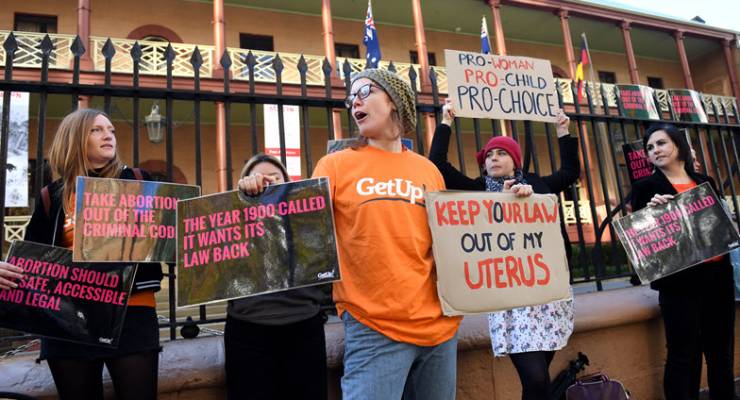
This week Australian media reported the case of a Sydney woman charged and convicted under the NSW Crimes Act for taking medication with the intent to procure an abortion at 28 weeks of pregnancy. The medication was misoprostol, widely used in obstetric practice for initiating labour, treating heavy bleeding and, with the drug mifepristone (RU486), for medical abortion. According to the case report, after taking the drug the woman became unwell and presented to hospital, where foetal distress was diagnosed, a caesarean section was performed and a live-born child was delivered.
It is rare for a woman to seek an abortion at this late stage in pregnancy. Less than 2% of all abortions are performed at or after 20 weeks, and most of these before 24 weeks.
There are almost always complex reasons for requests for late abortion, including severe foetal abnormalities or major physical or mental health risks for the woman. In NSW and Queensland, where abortion remains illegal, it can be difficult to get timely access to services and weeks pass while the woman searches for help.
[Labor gears up for internal fight over abortion]
The available facts are limited in the Sydney case. The convicted woman faced pressure from her partner to have an abortion. She was 28-years-old and had five children under ten. She had tried to contact a number of services to obtain an abortion. Finally, she found someone known as “Patrick” who provided telephone advice and, for the extortionate sum of $2000, sent her tablets that would have cost a few dollars at her local pharmacy.
The woman had her case heard by a magistrate. The highest possible penalty was two years in jail. She had the option of a jury trial, however this would have taken longer, would have cost more and would have placed her at risk of 10 years in jail. Little wonder she opted for a trial in front of a magistrate.
The case report concentrates largely on the meaning of the word “miscarriage” in the legislation and concludes that the woman did in fact intend to procure a “miscarriage” even though she had a live-born child. The NSW Crimes Act dates back to the 19th century and it’s enough for the woman to intend to procure an abortion to be convicted.
The magistrate referred to previous cases, but not to a very similar case in Cairns. In 2010 a Cairns couple were charged with procuring an abortion for the woman, at around six weeks of pregnancy. They admitted to police that they had obtained misoprostol and mifepristone from overseas and that the woman had taken the drugs to induce an abortion. They were charged under the Queensland Criminal Code sections that correspond to the NSW Crimes Act and pleaded not guilty in front of a jury.
In directions to the jury the judge explained that the prosecution must prove, beyond reasonable doubt, that the woman had administered a “noxious thing” to herself. He said that the question of whether the drug administered was noxious depended on whether it was noxious to the woman, and not to the foetus. A medical expert gave evidence that mifepristone and misoprostol were not “noxious” to the woman. The couple were acquitted.
[Case closed: experts loudly back decriminalisation of abortion in Qld]
Fast forward to the Sydney case where the magistrate suggested that the point of abortion law is to protect the foetus. When English law was introduced in 1861 — the same law that is still in place in NSW and Queensland — the aim was to protect women from backstreet abortionists. Moreover, the magistrate did not mention the role of the woman’s partner, who was clearly complicit in the decision-making, whereas in the Cairns case both the woman and her partner were prosecuted.
We can only speculate about what a jury might have done in the Sydney case and whether a NSW judge would have taken the Queensland approach and directed a jury that the drug must be noxious to the woman.
These are the only two reported cases in Australian history where a woman has been charged with trying to abort her own pregnancy. The divergent results of these two cases send a confusing message about medical abortion to women and to their clinicians and may make access to safe legal abortion even more difficult for women in NSW. And it is well established that when women seek abortion and fail to find it safely and legally they turn to unsafe and illegal options — the “Patricks” of the internet. It is equally well-known that abusive relationships and difficult social circumstances are common reasons for women to seek abortion.
NSW has the oldest abortion law in the country — it hasn’t been updated for over 100 years and there have been significant developments in medicine and in expectations surrounding women’s autonomy since then. The Sydney woman is now on a bond and has a criminal conviction. What was gained by dragging her through this experience? This question can also be asked about the Cairns couple prosecuted in 2010, and the twelve year old girl forced to go to the Queensland Supreme Court for permission for an abortion in 2016. In most other Australian states the woman herself can no longer be charged with procuring her own abortion. The Sydney case is further evidence of the need to decriminalise the archaic abortion laws of NSW and Queensland, now the only jurisdictions in Australia where this has not occurred.







But why should it have to be noxious to the woman? Is suicide or attempted suicide still illegal? Is self harm illegal?
Man, I hope the Sydney woman appeals her conviction.
un.be.liev.able.
“and a live-born child was delivered”–that’s good–not bad surely?